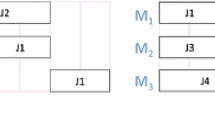Abstract
The concurrent open shop problem is a relaxation of the well known open job shop problem, where the components of a job can be processed in parallel by dedicated, component specific machines. Recently, the problem has attracted the attention of a number of researchers. In particular, Leung et al. (2005) show, contrary to the assertion in Wagneur and Sriskandarajah (1993), that the problem of minimizing the average job completion time is not necessarily strongly NP-hard. Their finding has thus once again opened up the question of the problem's complexity. This paper re-establishes that, even for two machines, the problem is NP-hard in the strong sense.
Similar content being viewed by others
References
Ahmadi, R. H. and U. Bagchi, “Scheduling of Multi-Job Customer Orders in Multi-Machine Environments,” ORSA/TIMS, Philadelphia, 1990.
Ahmadi, R. H. and U. Bagchi, “Coordinated Scheduling of Customer Orders,” Working Paper, Anderson School at UCLA (1993).
Ahmadi, R. H. and U. Bagchi, “Coordinated Scheduling of Customer Orders,” updated Working Paper, Anderson School at UCLA (1997).
Ahmadi, R. H., U. Bagchi, and T.A. Roemer, “Coordinated Scheduling of Customer Orders for Quick Response,” forthcoming in Naval Research Logistics (2006).
Baker, K. R., Introduction to sequencing and scheduling, Wiley, New York 1974.
Chen Z. L. and N. G. Hall, “Supply chain scheduling: Assembly systems,” Working Paper, Department of Systems Engineering, University of Pennsylvania 2000.
Graham, R. L., E. L. Lawler, J. K. Lenstra, and A. H. G. Rinnooy Kan, “Optimization and Approximation in Deterministic Sequencing and Scheduling: A Survey,” Annals of Discrete Mathematics, 5, 287–326 1979.
Lee, C.-Y., T. C. E. Cheng, and B. M. T. Lin, “Minimizing the Makespan in the 3-Machine Assembly-Type Flowshop Scheduling Problem,” Management Science, 39(5), 616–625 1993.
Leung, J.Y.-T, H. Li, and M. Pinedo, “Order Scheduling in an Environment with Dedicated Resources in Parallel,” Journal of Scheduling, 8, 355–386 2005a.
Leung, J.Y.-T, H. Li, and M. Pinedo, “Scheduling Orders for Multiple Product Types to Minimize Total Weighted Completion Time,” Working Paper 2005b.
Leung, J.Y.-T, H. Li, and M. Pinedo, “Order Scheduling Models: An Overview,” In Multidisciplinary scheduling: Theory and applications , G. Kendall, E. K. Burke, S. Petrovic and M. Gendreau (eds.), Springer, New York, 2005c.
Leung, J.Y.-T, H. Li, M. Pinedo and C. Sriskandarajah, “Open shops with jobs overlap—revisited,” European Journal of Operational Research, 163, 569–571 2005.
Morton, T. E. and D. W. Pentico, Heuristic Scheduling System, Wiley, New York (1993).
Ng, C.T., T. C. E. Cheng, and J. J. Yuan, “Concurrent Open Shop Scheduling to Minimize the Weighted Number of Tardy Jobs,” Journal of Scheduling, 6, 405–412 (2003).
Pinedo, M., Scheduling: Theory, algorithms and systems, Prentice Hall, Englewood Cliffs, NJ (2002).
Potts, C. N., S. V. Sevast Janov, V. A. Strusevich, L. N. Van Wassenhove and C. M. Zwaneveld, “The Two-Stage Assembly Scheduling Problem: Complexity and approximations,” Operations Research, 43(2), 346–355 1995.
Roemer, T. A. and R. Ahmadi, “The Complexity of Scheduling Customer Orders,” Working Paper, Anderson School at UCLA (1997a).
Roemer, T. A. and R. Ahmadi, “The Complexity of Scheduling Customer Orders,” INFORMS, Dallas (1997b).
Sung, C. S. and S. H. Yoon, “Minimizing total weighted completion time at a pre-assembly stage composed of two feeding machines,” International Journal of Production Economics, 54, 247–255 (1998).
Wagneur, E. and C. Sriskandarajah, “Open shops with jobs overlap,” European Journal of Operational Research, 71, 366–378 (1993).
Wang, G. and T. C. E. Cheng, “Customer Order Scheduling To Minimize Total Weighted Completion Time,” In Proceedings of the first Multidisciplinary Conference on Scheduling Theory and Applications, 2003, pp. 409–416.
Yang, J., “The complexity of customer order scheduling problems on parallel machines,” Computers & Operations Research, 32, 1921–1939 2005.
Yang, J. and M. E. Posner, “Scheduling Parallel Machines For The Customer Order Problem,” Journal of Scheduling, 8, 49–74 (2005).
Author information
Authors and Affiliations
Corresponding author
Rights and permissions
About this article
Cite this article
Roemer, T.A. A note on the complexity of the concurrent open shop problem. J Sched 9, 389–396 (2006). https://doi.org/10.1007/s10951-006-7042-y
Issue Date:
DOI: https://doi.org/10.1007/s10951-006-7042-y




